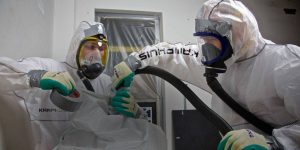Asbestos Certification in Newcastle
Introduction

Asbestos, a naturally occurring mineral, was once widely used in the construction industry for its durability and resistance to heat. However, its potential health hazards have led to stringent regulations surrounding its handling and removal.
In New Castle, professionals dealing with asbestos must be well-informed and certified. This blog post delves into the world of asbestos certification in New Castle, outlining the importance of being informed and properly trained in this field.
What is Asbestos and Why is Certification Crucial?
What is asbestos? Simply put, it’s a fibrous mineral used in building materials for insulation and as a fire retardant. Its fibers, when airborne and inhaled, can cause serious health issues, including lung cancer and mesothelioma. This is where the significance of asbestos certifications comes into play. These certifications ensure that professionals are equipped with the knowledge and skills to handle asbestos safely, minimizing the risk of exposure.
Asbestos Inspection Certification: Ensuring Safe Environments
One of the key aspects of managing asbestos is inspection. Asbestos inspection certification empowers professionals to identify and assess the presence of asbestos in buildings. This is particularly vital during demolitions, renovations, or when older buildings are being repurposed. An asbestos building inspector plays a critical role in ensuring that these environments are safe for occupancy and work.
The Process of Asbestos Removal: A Detailed Overview
Asbestos removal, a task that demands meticulous attention to detail, is a complex and delicate process. It requires a combination of expertise, precision, and a deep understanding of both the material and the associated health risks. The process isn’t merely about removing the asbestos; it’s fundamentally about ensuring that the removal is conducted in a manner that safeguards the health and safety of both the workers involved and the surrounding environment. Let’s delve deeper into each step of the process to understand why each is crucial.
Inspection and Assessment
The first step in the asbestos removal process is a thorough inspection and assessment of the site. This involves identifying materials that contain asbestos, assessing their condition, and determining the risk they pose. This step is crucial because not all asbestos-containing materials need immediate removal; some might be safe if undisturbed. This phase also involves testing, which is usually done by collecting samples and sending them to a laboratory for analysis.
Planning the Removal Process
Once the presence of asbestos is confirmed, a detailed plan for its removal is drafted. This step involves strategizing the safest and most efficient way to remove the asbestos while minimizing the risk of fiber release. The plan includes choosing appropriate removal methods (like encapsulation or complete removal), determining the necessary equipment and protective gear, and scheduling the removal to minimize exposure to occupants.
Implementing Safety Measures
Safety is paramount in asbestos removal. Before the actual removal process begins, safety measures are put in place. This includes sealing off the area with plastic sheeting and duct tape to prevent asbestos fibers from spreading, setting up decontamination units, and ensuring that all personnel involved are equipped with personal protective equipment (PPE) like respirators, gloves, and protective suits. Air monitoring is also conducted to ensure that asbestos fibers are not being released into the environment.
Actual Removal
The actual removal of asbestos is a highly controlled process. Professionals use specific techniques to minimize the disturbance of the asbestos materials, thereby reducing the risk of fiber release. This might include wetting materials to prevent dust formation or using specialized tools for careful removal. The removed asbestos is then placed in secure, labeled bags for proper disposal.
Disposal of Asbestos Materials
Disposal is the final step in the asbestos removal process and is as critical as the removal itself. Asbestos waste must be disposed of in a manner that complies with local and federal regulations. This typically involves transporting the sealed bags to a designated hazardous waste facility. Proper disposal ensures that asbestos materials do not pose a risk to public health or the environment after removal.
Training and Education: The Backbone of Asbestos Management
Without proper training, handling asbestos can be dangerous. This is where education programs and asbestos certifications come into play. These programs cover:
- Identification of asbestos-containing materials
- Understanding the health risks associated with asbestos exposure
- Learning safe removal and disposal methods
- Familiarizing with legal requirements and safety standards
Asbestos Testing and the Role of Test Kits
Asbestos testing
Is a crucial step in identifying the presence of asbestos in materials. Professionals often use an Asbestos test kit, which helps in taking samples of suspected materials and sending them to a lab for confirmation. This step is fundamental before any renovation or demolition work in older buildings.
The Health Implications of Asbestos Exposure
Understanding Asbestos exposure and its health implications is a vital part of asbestos management. Long-term exposure to asbestos fibers can lead to serious respiratory diseases. This knowledge underpins the importance of proper handling and removal techniques to protect workers and the public.
The Role of an Asbestos Consultant

An Asbestos consultant is a specialized professional who provides expert advice on asbestos management, from identification to removal. They play a critical role in ensuring that all procedures comply with health and safety regulations, thereby safeguarding the well-being of those involved.
How Often to Update Asbestos Abatement Certification
A common question in this field is, how often do I need to update my asbestos abatement certification? Regular updates and refresher courses are essential, as regulations and safety protocols can change. Staying current ensures that professionals are always operating with the latest knowledge and techniques.
Conclusion
In the realm of asbestos management, the importance of staying informed, certified, and compliant cannot be overstated. The health risks associated with asbestos, the complexity of its removal, and the strict regulations governing its handling all underscore the need for expertise and vigilance in this field. Professionals in New Castle have a crucial role in ensuring that our buildings and environments are safe and asbestos-free.
At Rapid Demolition, we are committed to upholding the highest standards of safety and professionalism in asbestos management. Our team is equipped with the expertise to assist you in every aspect of asbestos management, including asbestos inspection certification, asbestos removal, and ensuring all activities are in compliance with the latest regulations. We understand the nuances of asbestos management and are dedicated to providing services that not only meet but exceed the required safety standards.
